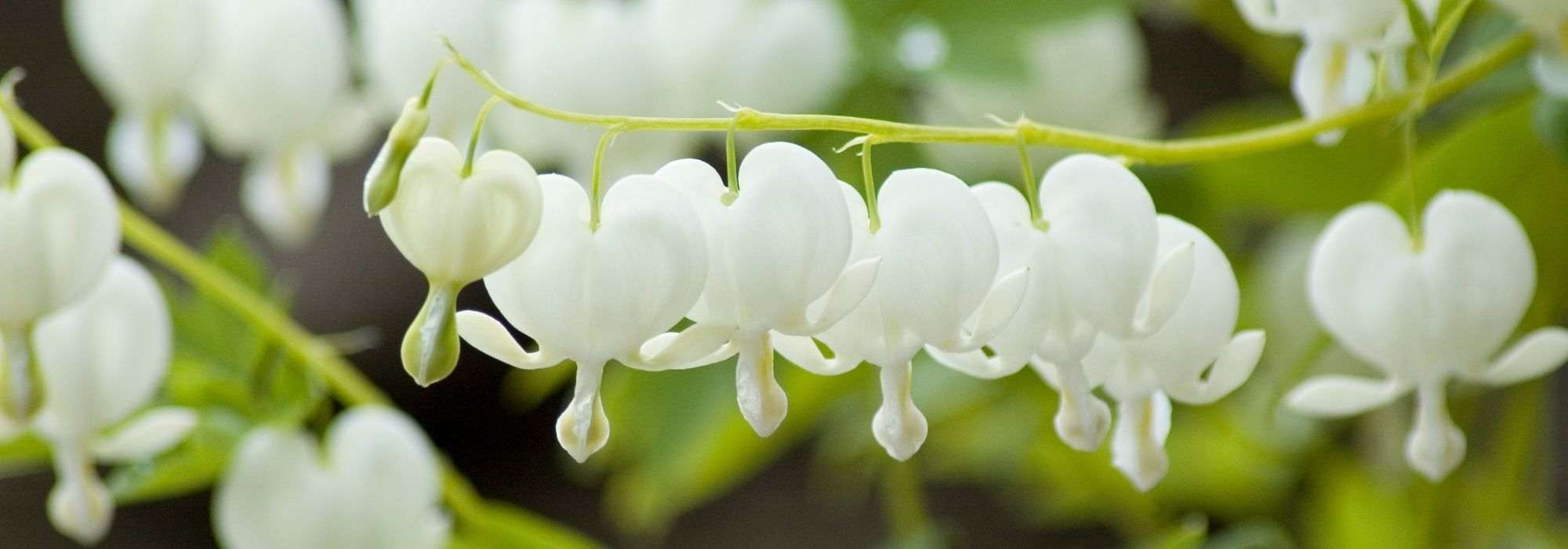
Bleeding heart: the most beautiful varieties
to adopt in the garden
Contents
The Bleeding Heart, also known as Saignant Heart or Jeannette’s Heart (now Lamprocapnos spectabilis), was always present in our grandmothers’ gardens and vicarage gardens. Over time, it has remained in vogue and is still a must-have in natural or romantic gardens today. The grace of its heart-shaped flowers contributes to this. The Dicentra offers us a wide range of flowers in various colours and shapes, all equally beautiful. Its foliage is also very varied depending on the species and cultivars. Golden yellow, green, or silver leaves, more or less dissected, there is something for everyone. Moreover, when grown under the right conditions, this hardy plant is easy to cultivate. It only requires shade, cool soil in summer, not waterlogged in winter, and the same location for life, as it does not tolerate being moved well. A perennial that is truly worth a visit. Discover the most beautiful Bleeding Hearts from our collection and succumb to their charm!
Dicentra spectabilis 'Gold Heart': a golden variety
This bleeding heart is excellent for brightening shaded areas! The Dicentra spectabilis ‘Gold Heart’, very similar to the species type Dicentra spectabilis, adds a pop of colour to borders thanks to the colour of its foliage. In spring, this cultivar is adorned with beautiful yellow leaves that catch the eye. When flowering occurs from May to June, this perennial offers a lovely contrast of colours. The bright leaves with broad lobes highlight the vivid colour of the pink, heart-shaped flowers that rise above the rounded clump. To ensure this bleeding heart retains its beautiful golden hue, plant it in partial shade. It can tolerate full sun in moist soil, but its foliage will then become less interesting, gradually turning green. The Dicentra spectabilis ‘White Gold’ is its counterpart with pure white flowers. Easily reaching 60 cm in height and 40 cm in width, plant this large bleeding heart in borders alongside Omphalodes verna or cappadocica, Japanese anemones, Astilbe chinensis ‘Veronica Klose’, and Polystichum setiferum.
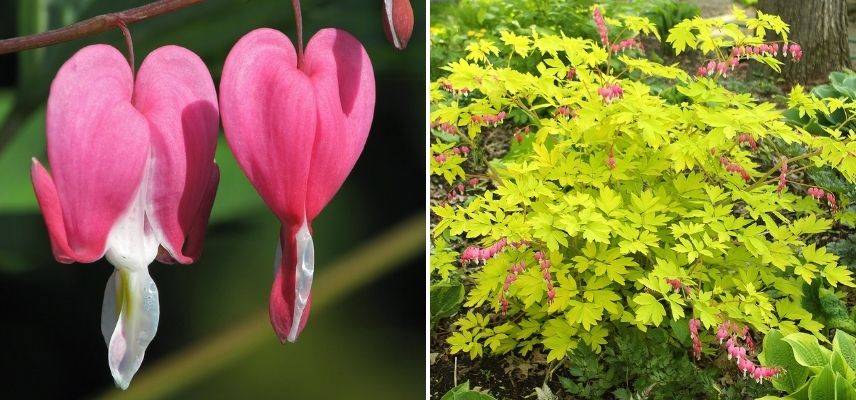
Dicentra spectabilis ‘Gold Heart’ (photo on the left from Wikipedia)
Dicentra 'Ivory Hearts': purity and elegance
Remarkable for its delicately cut grey-green foliage reminiscent of chervil, Dicentra ‘Ivory Hearts’ reveals a wonderful and long flowering period from May to September, sometimes starting early in April and extending into October depending on the climate. This homogeneous and dense clump is adorned with clusters of pendulous ivory-white flowers. Its hearts are small, about 2 centimetres. The two upturned spurs surrounding the tip of the heart are particularly long and prominent compared to the curvature of the heart. This luminous perennial, reaching 30 cm in all directions at maturity, thrives in deep, humus-bearing soil, preferably in shade. In partial shade, morning or late afternoon sun is tolerable. With its refined style, the Bleeding Heart ‘Ivory Hearts’ is perfect at the feet of bushes in a white garden, alongside variegated Hostas in green and cream, Astrantia major ‘Shaggy’, Lamium maculatum ‘White Nancy’, and grasses or varieties of Heucheras with green foliage.
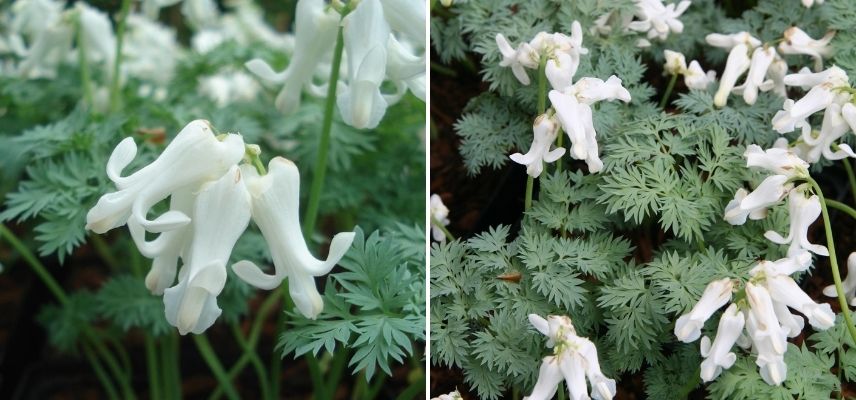
Dicentra ‘Ivory Hearts’
Discover other Dicentra - Bleeding Hearts
View all →Available in 0 sizes
Available in 3 sizes
Available in 3 sizes
Available in 2 sizes
Available in 3 sizes
Available in 1 sizes
Available in 1 sizes
Available in 0 sizes
Available in 1 sizes
Available in 1 sizes
Dicentra formosa 'Bacchanal': a deep red
With its generous flowering and exceptional hue, Dicentra formosa ‘Bacchanal’ is one of the few bleeding hearts to have such dark flowers! Awarded in 2002 by the Royal Horticultural Society, this Dicentra has finely cut pale green foliage, reminiscent of ferns, with a trailing and spreading habit. Its inflorescences develop from May to July at the tips of the upright flower stems, which extend well beyond the plant. These wine-red hearts, pendulous in clusters, are less notched than the very rounded and well-defined hearts of Dicentra spectabilis, but this does not detract from its charm! The bleeding heart ‘Bacchanal’ prefers partial shade, although it tolerates gentle sun if the soil remains well moist. Planted at the edge of a shaded border in humus-bearing soil, its groundcover foliage blends perfectly with Alchemilla sericata ‘Gold Strike’, Caucasian forget-me-nots, Solomon’s seal, and lungwort.
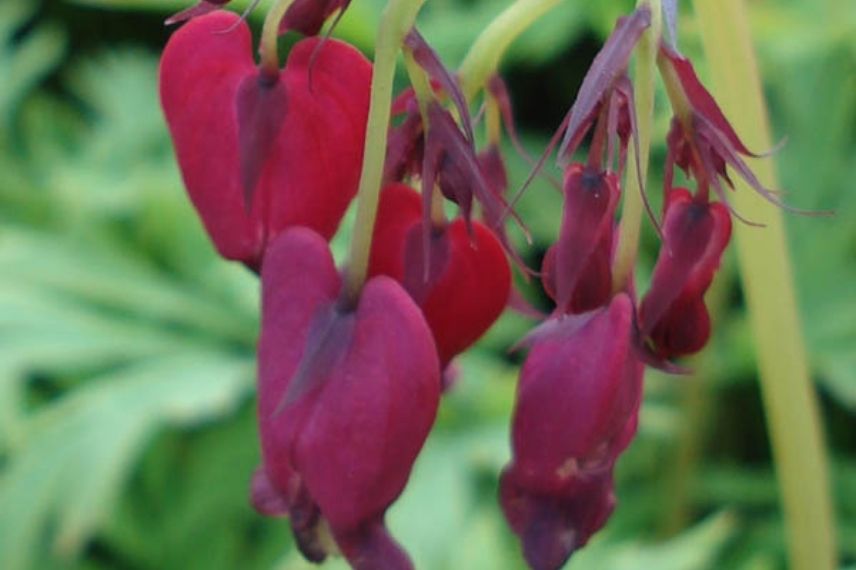
Dicentra formosa ‘Bacchanal’
Dicentra 'Burning Hearts': a long and vibrant flowering
With foliage similar to that of Dicentra ‘Ivory Hearts’, Dicentra ‘Burning Hearts’ stands out with its colourful flowers. Indeed, it produces for several months, from early spring to late summer, hearts of a striking red with a hint of fuchsia, whose large curved spurs are highlighted by a fine white line. This variety with its vibrant heart-shaped flowers truly lives up to its name, which means “Burning Hearts”. Its bushy stump with green-grey foliage develops rapidly thanks to its rootstock and reaches its maximum spread in two years. Its dense silhouette then stands about forty centimetres tall with a spread of thirty centimetres. The bleeding heart ‘Burning Hearts’ is not afraid of the root competition from neighbouring plants and adds colour to the garden when paired with Bergenias, Elf’s Flower, hardy geraniums, and small Astilbes.
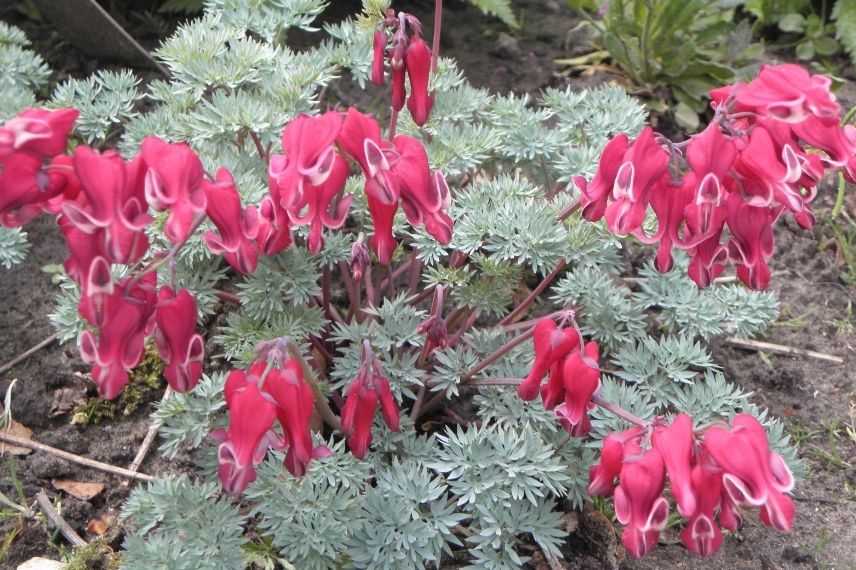
Dicentra ‘Burning Hearts’ (photo Wikipedia)
Dicentra cucullaria: unique upright flowers
Here is a lesser-known Dicentra that deserves more recognition. The Dicentra cucullaria has a flowering pattern quite different from other bleeding hearts, which typically bear heart-shaped flowers. Indeed, from April to May, the hooded bleeding heart adorns itself with small white flowers that have a unique appearance: they resemble little donkey bonnets! Two small yellow lips curved downwards are topped by two large white petals, standing upright like alert ears. Native to North America, this very hardy perennial can withstand temperatures below -15°C. It particularly enjoys shady, moist conditions and soils rich in humus. Furthermore, its modest, creeping habit is well-suited for planting in cool rockeries, where it forms a clump that is wider than it is tall: 30 cm in height with a spread of 40 cm. Also known as Dutchman’s breeches, its finely cut grey-blue foliage makes a striking impression in woodlands. Pair it with Josephine periwinkle, dwarf hostas, creeping bugle, and pachysandra. This bleeding heart can also be grown solitary in a pot, in the shade, with regular watering.
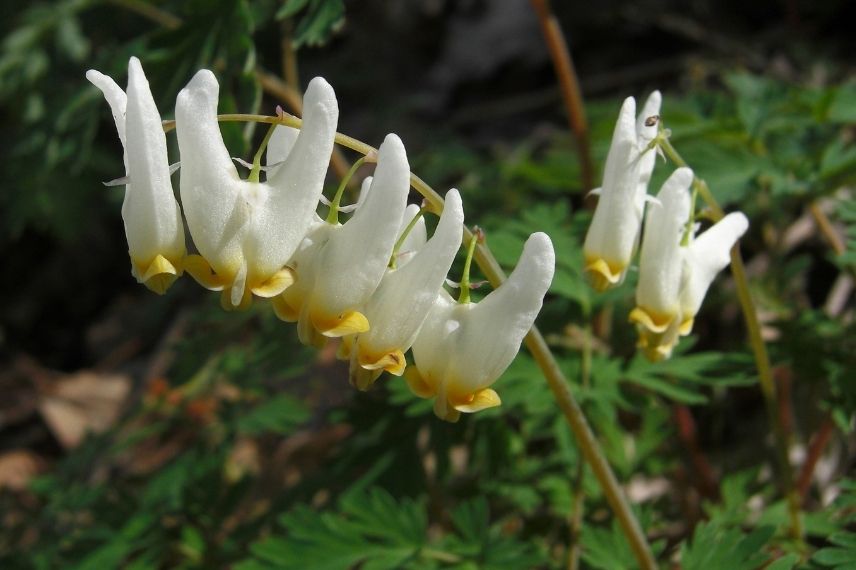
Dicentra cucullaria (photo Wikipedia)
Dicentra spectabilis 'Valentine': a blood-red flowering
Just like Dicentra spectabilis ‘Gold Heart’, Bleeding Heart ‘Valentine’ features deeply cut foliage, unlike Dicentra cucullaria, Dicentra formosa ‘Bacchanal’, and the previously mentioned varieties ‘Burning Hearts’ and ‘Ivory Hearts’. This foliage with changing colours is one of its assets. Initially tinged with purple as it emerges, sometimes leaning towards copper, it then turns green with a hint of grey by early summer. Like all Dicentras, its foliage eventually disappears, leaving the space it occupies bare during winter. But that’s not all! This recent variety with rapid growth showcases a multitude of heart-shaped flowers in a vibrant cherry red from May to July. These are regularly suspended, one after the other, along purple floral stems. Their white leading shoots distinctly rise above the petals. Preferring shade and coolness in summer, the edge of a woodland is the ideal spot for this perennial. Grow it in well-drained soil that does not retain too much water in winter, surrounded by Wild Anemone, Saxifrage ‘Beni Tsukasa’, Japanese Primrose White, Hakonechloa macra ‘Beni-Kaze’, and ferns.
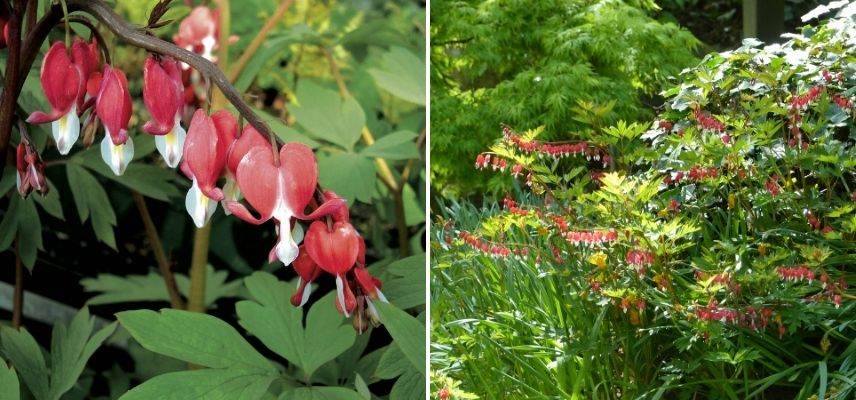
Dicentra spectabilis ‘Valentine’
To find out more
Also, check out our comprehensive file: Bleeding heart: planting, cultivation, and companion planting
- Subscribe!
- Contents
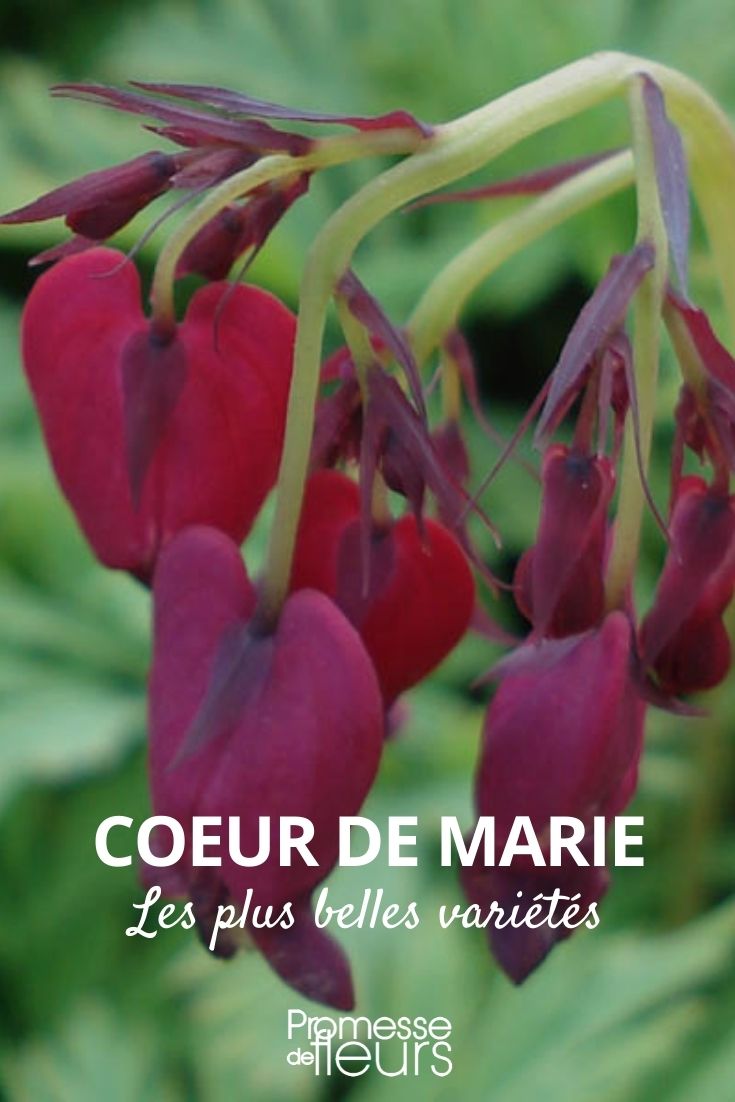































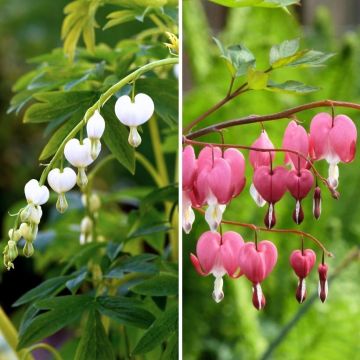
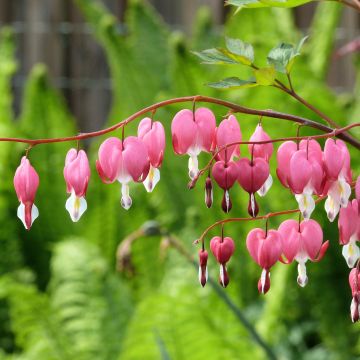
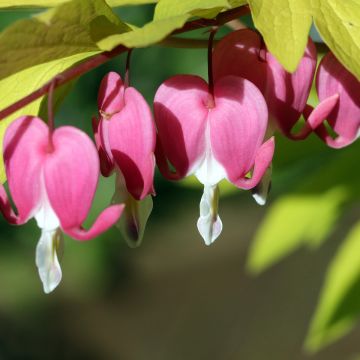
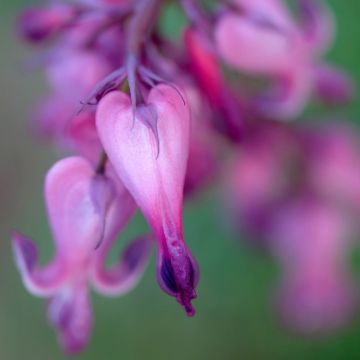
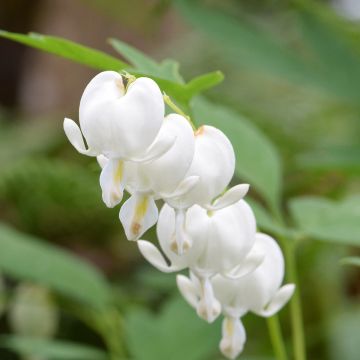
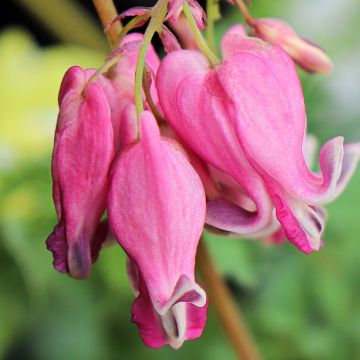
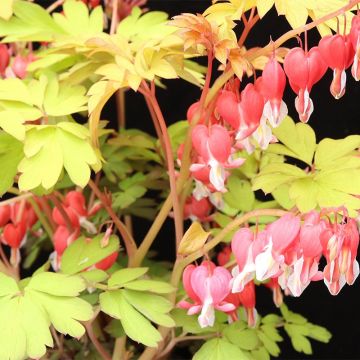
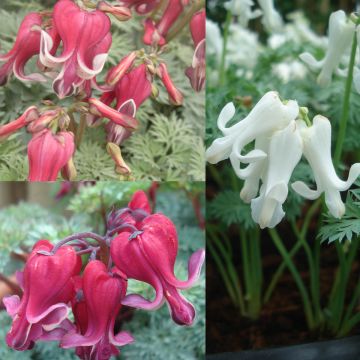
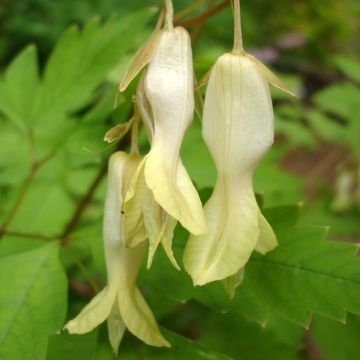
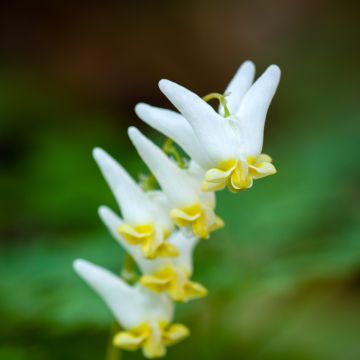
Comments